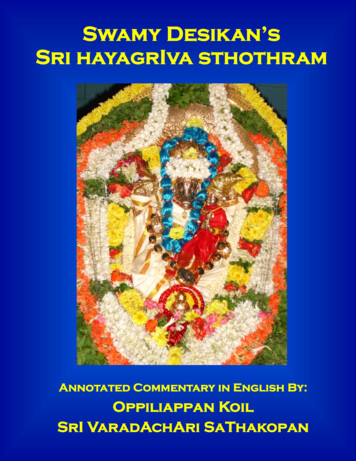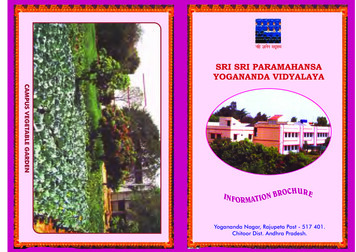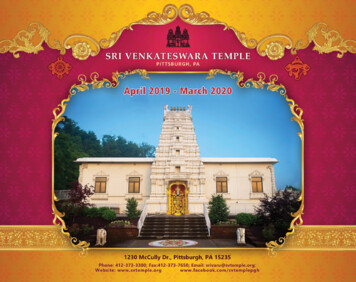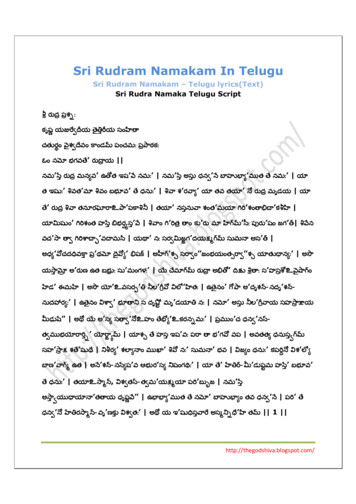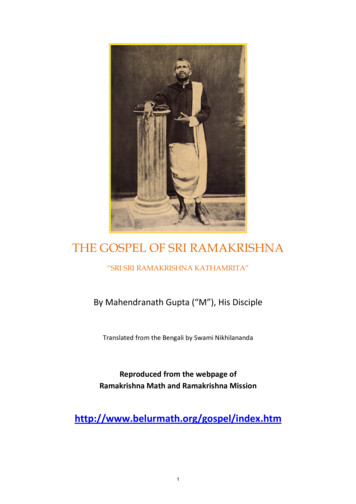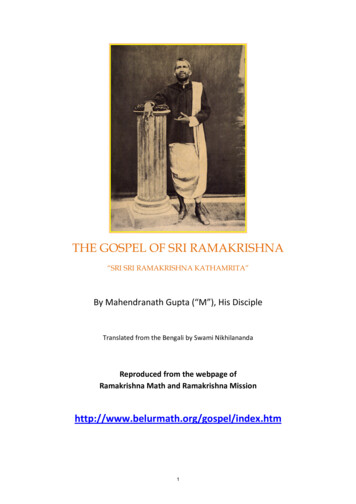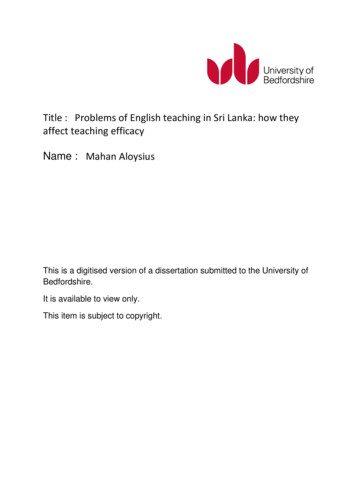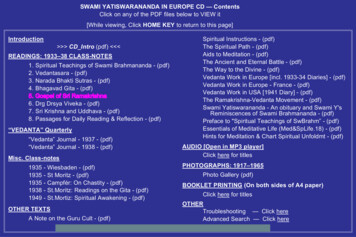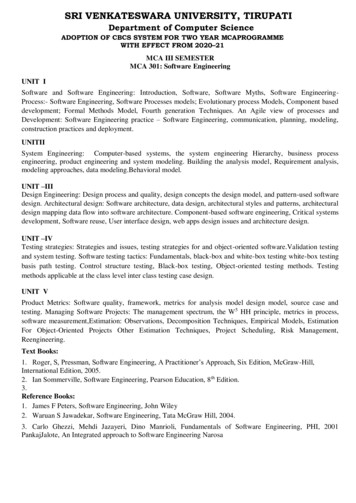
Transcription
SRI VENKATESWARA UNIVERSITY, TIRUPATIDepartment of Computer ScienceADOPTION OF CBCS SYSTEM FOR TWO YEAR MCAPROGRAMMEWITH EFFECT FROM 2020–21MCA III SEMESTERMCA 301: Software EngineeringUNIT ISoftware and Software Engineering: Introduction, Software, Software Myths, Software EngineeringProcess:- Software Engineering, Software Processes models; Evolutionary process Models, Component baseddevelopment; Formal Methods Model, Fourth generation Techniques. An Agile view of processes andDevelopment: Software Engineering practice – Software Engineering, communication, planning, modeling,construction practices and deployment.UNITIISystem Engineering: Computer-based systems, the system engineering Hierarchy, business processengineering, product engineering and system modeling. Building the analysis model, Requirement analysis,modeling approaches, data modeling.Behavioral model.UNIT –IIIDesign Engineering: Design process and quality, design concepts the design model, and pattern-used softwaredesign. Architectural design: Software architecture, data design, architectural styles and patterns, architecturaldesign mapping data flow into software architecture. Component-based software engineering, Critical systemsdevelopment, Software reuse, User interface design, web apps design issues and architecture design.UNIT –IVTesting strategies: Strategies and issues, testing strategies for and object-oriented software.Validation testingand system testing. Software testing tactics: Fundamentals, black-box and white-box testing white-box testingbasis path testing. Control structure testing, Black-box testing, Object-oriented testing methods. Testingmethods applicable at the class level inter class testing case design.UNIT VProduct Metrics: Software quality, framework, metrics for analysis model design model, source case andtesting. Managing Software Projects: The management spectrum, the W5 HH principle, metrics in process,software measurement,Estimation: Observations, Decomposition Techniques, Empirical Models, EstimationFor Object-Oriented Projects Other Estimation Techniques, Project Scheduling, Risk Management,Reengineering.Text Books:1. Roger, S, Pressman, Software Engineering, A Practitioner’s Approach, Six Edition, McGraw-Hill,International Edition, 2005.2. Ian Sommerville, Software Engineering, Pearson Education, 8 th Edition.3.Reference Books:1. James F Peters, Software Engineering, John Wiley2. Waruan S Jawadekar, Software Engineering, Tata McGraw Hill, 2004.3. Carlo Ghezzi, Mehdi Jazayeri, Dino Manrioli, Fundamentals of Software Engineering, PHI, 2001PankajJalote, An Integrated approach to Software Engineering Narosa
MCA 302: Computer GraphicsUNIT IOverview of Graphics systems, Application areas of Computer Graphics, video-display devices, Raster-scansystems, random scan systems, graphics monitors and workstations and input devices. Output primitives:Points and lines, line drawing algorithms, mid-point circle and ellipse algorithms.UNIT IIFilled area primitives: Scan line polygon fill algorithm, boundary-fill and flood-fill algorithms. 2-DGeometrical transforms: Translation, scaling, rotation, reflection and shear transformations, matrixrepresentations and homogeneous coordinates.UNIT III2-D Viewing: The viewing pipeline, viewing coordinate reference frame, window to view-port coordinatetransformation, viewing functions, Cohen-Sutherland and Cyrus-beck line clipping algorithms, Sutherland –Hodgeman polygon clipping algorithm.UNIT IV3-D Object representation: Polygon surfaces, quadric surfaces, spline representation, Hermite curve, Beziercurve and B-spline curves, Bezier and B-spline surfaces. Basic illumination models, polygon renderingmethods.UNIT V3-D Geometric transformations: Translation, rotation, scaling, reflection and shear transformations, compositetransformations, 3-D viewing: Viewing pipeline, viewing coordinates, view volume and general projectiontransforms and clipping.Computer Animation: Design of animation sequence, general computer animation functions, Rasteranimations, Computer animation languages, Key frame systemsText Books:1. Donald Hearn and M.Pauline Baker, Computer Graphics C Version, Second Edition, PearsonEducations.2005.Reference Books:1. Steven Harrington (1987), Computer Graphics – A Programming Approach, Second Edition, McGraw –Hill International Editions.2. William M. Newman and Robert F. Sprowli (1979), Principles of Interactive Computer Graphics, secondEdition, McGraw – Hill International Editions.MCA 303:Web TechnologiesUNITIIntroduction to Internet-Browser Architecture-IE: Chrome-Search Engines-Introduction to HTML-5-HTML-5Tags-Audio, Video Tags – HTML-5 Forms-Controls-CSS Styling-CSS Tags-Attributes.UNIT IIJava Script-JQuery: JavaScript Programming Scripts- Control structures- Functions-Document, Browser,Date, Math, String objects-Events- JQuery Libraries-JQuery Objects, Functions – JQuery Events-Animations.
UNIT IIIAJAX Concepts: Simple AJAX objects-Ajax Libraries-Examples, Webservers IIS, Tomcat-Hosting Websitein a Web servers.UNIT IVIntroduction to PHP: Control Structures-Arrays-Functions-Database connectivity-Introduction to ZENDFramework and applicationsUNIT-VIntroduction to Java Servlets: Servlet classes and interfaces - Java Database Connectivity- Introduction toJSP-Java Server Page scriptlets -JSP Objects-JSP Web applications.Text Books:Deitel, Deitel and Goldberg Internet & World Wide Wide how to program”by End. Pearson EducationIvan Bayross, Webenavled commercial Application Development in Java 2.0 BPB.HTML 5 Black book, Kogent Learning Solutions Inc.Reference Books:Raj Kamal Internet and web Technologies, Tata McGraw Hill, 2002.Chirs Bates, Web Programming, John Wiley, 2nd EditionMCA 304A: Data Warehousing and DataminingUNIT IData warehousing and OLAP:Data Warehouse basic concepts, Data Warehouse Modelling, Data Cube andOLAP: Characteristics of OLAP systems, Multidimensional view and Data cube, Data Cube Implementations,Data Cube operations, Implementation of OLAP and overview on OLAP Software.UNIT IIData Mining and its Applications :Introduction, What is Data Mining, Motivating Challenges, Data MiningTasks, Which technologies are used for data mining, Kinds of pattern that can be mined, Data MiningApplications, Data Pre-processing, Data cleaning, data integration, data reduction and data transformation.UNIT IIIAssociation Analysis: Basic Concepts and Algorithms :Frequent Item set Generation, Rule Generation,Compact Representation of Frequent Item sets, Alternative methods for generating Frequent Item sets, FPGrowth Algorithm, Evaluation of Association PatternsUNIT IVClassification: Methods, Improving accuracy of classification:Basics, General approach to solve classificationproblem, Decision Trees, Rule Based Classifiers, NearestNeighbour Classifiers. Bayesian Classifiers,Estimating Predictive accuracy of classification methods, Improving accuracy of classification methods,Evaluation criteria for classification methods, Multiclass Problem.UNIT VClustering Techniques: Overview: Features of cluster analysis, Types of Data and Computing Distance, Typesof Cluster Analysis Methods, Partitional Methods, Hierarchical Methods, Density Based Methods, Qualityand Validity of Cluster AnalysisText Books:1.Jiawei Han and MichelineKamber: Data Mining - Concepts and Techniques, 2nd Edition, MorganKaufmann Publisher, 2006.2.Pang-Ning Tan, Michael Steinbach, Vipin Kumar: Introduction to Data Mining, Addison- Wesley,2005.Reference Books:1.Arun K Pujari: Data Mining Techniques University Press, 2nd Edition, 2009.2.G. K. Gupta: Introduction to Data Mining with Case Studies, 3rd Edition, PHI, New Delhi, 2009.3.Alex Berson and Stephen J.Smith: Data Warehousing, Data Mining, and OLAP ComputingMcGrawHill Publisher, 1997
MCA 304B:Big Data AnalyticsUNIT IWhat is Big Data : Varieties of Data – Unstructured data – Trends in Data Storage - Basically Available SoftState Eventual Consistency (BASE) - Industry Examples of Big Data.NIT - IIBig Data Technology: New and older approaches – Data Discovery –Terminologies used in Big DataEnvironments- Open Source technologies for Big Data Analytics – Cloud and Big Data – Big DataFoundation – Computation – Limitations – Big Data Emerging Technologies.UNIT IIIBusiness Analytics –Consumption of Analytics – Creation to Consumption of Analytics – Data visualizationby Organizations – 90/10 rule of critical thinking – Decision sciences and analytics – Learning overknowledge – Agility – Scale and convergence – Privacy and security in Big Data.UNIT IVPredictive Analytics – Target Definition - Linear Regression – Logistic Regression - Decision trees – NeuralNetworks – Support Vector machines - Classification trees – Ensemble methods – Association Rules –Segmentation , Sequence Rules, Social Network analytics.UNIT VHadoop – Why Hadoop? – Why not RDBMS? – RDBMS Versus Hadoop - Components of Hadoop – HadoopFile System – Hadoop Technologies Stack – Managing Resources and Applications with Hadoop YARN Dataware housing Hadoop Concepts – Applications of Hadoop using PIG,YARN,HIVE.Text Books1. Big Data and Analytics, seemaAcharya ,Subhashinichellapan, Wiley publicaitons2. Baesens, 2014, Analytics in a Big Data World: The Essential Guide to Data Science and Itsapplications, Wiley India Private LimitedReference Books“Big Data Analytics: Systems, Algorithms, Applications” Prabhu, C.S.R., SreevallabhChivukula,A., Mogadala, A., Ghosh, R., Livingston, L.M.J.MCA 304C: System ProgrammingUNIT IBackground introduction, system software and machine architecture, SIC, RISC, and CISC architecture.Assembler: basic assembler functions, machine dependent and independent assembler features, assemblerdesign options, and implementation examples.UNIT IILoading and linkers basic loader junction, machine dependent and independent loader features, loader designoptions and implementation examples. Macro processors, basic macro processor functions machines –independent macro processor features, macro processor design options, implementation examples.UNIT IIICompilers: basic compiler functions, machine dependent and independent compiler features, compiler designoptions and implementation examples. Other system software: text editors and interactive debugging systemsUNIT-IVIntroduction to Device Drivers, Design issues-Types of Drivers, Character driver-1 and Design issues,Character Driver-2- A/D converter and its design issues, Block driver-1 and its design issues.
UNIT-VIntroduction to Linux- Linux Architecture- X-windows- Linux administration tools - Commands to use LinuxOS- Executing Linux Shell scripts – Shell Programming concepts-Shell scripts.Text Books:1. Leland .Beck, System Software: An Introduction to systems programming :3/e, Pearson EducationsAsia,2003.2. George pajari, Writing Unix Drivers, Addison – Wesley, 1991.Reference Books:1. Richard Petersen, Linux complete Reference, McGraw Hill Education (India) Private Limited; 6 edition(21 November 20072. Dhamdhere, System programming and operation Systems Book 2/E, Tata McGraw, Hill, 1999MCA 305A:Cryptography and Network SecurityUNIT ICryptography – Terminology, Conventional Encryption Model, Steganography, Classical EncryptionTechniques, DES Data Encryption Standard, Block Cipher Design principles and Modes of Operation.UNIT IIConventional Encryption Algorithms: Triples DES, International Data Encryption Algorithm, Blowfish, RC5,Characteristics of advanced symmetric Block Ciphers, Confidentiality using Conventional Encryption.UNIT III:Public-Key Cryptography, Introduction to Number Theory: Prime Numbers, Modular Arithmetic,Euler‟s Theorem, Primary and Factorization, discrete logarithm, D-H Key sharing technique, RSA and itsvariants-Homomorphic Encryption Techniques Message Authentication and Hash Functions – Hash andMAC algorithms.UNIT IVDigital, Signatures and authentication Protocols, Digital Signature Standard, Network Security Practice,Authentication Applications. Basic overview of Electronic Mail Security: pretty Good Privacy‟s/MIME: IPSecurity, Web Security – Intruders, Viruses and Worms – Firewalls.UNIT VMobile Security, Risk Model, EcoSystem, Service Risks, App Risks, Countermeasures- Cloud ComputingSecurity- Threats-Security in Cloud.Security at service layers. Introduction to Block chain, Crypto currency,BitCoin Security and working, Ethereum.Text Books1.Cryptography and Network Security – by William Stallings, Principles and Practice, 7thEdition,Pearson2.Cryptography and Network Security, by John Wiley, Edn,.20013.Reference Books1. Bruce Schneier, Applied Cryptography, John Wiley, Second Edn,2001.2. Charke Kaufman, Rodia Perlman and Mike Speciner, Network Security
18MCA 305B: Artificial IntelligenceUNITIIntroduction Concept of AI, history, current status, scope, agents, environments, Problem Formulations,Review of tree and graph structures, State space representation, Search graph and Search treeUNIT IIRandom search, Search with closed and open list, Depth first and Breadth first search, Heuristic search, Bestfirst search, A* algorithm, Game Search.UNIT IIIProbability, conditional probability, Constraint Satisfaction, Propositional Logic &Satisfiability, Uncertaintyin AI, Bayes Rule, Bayesian Networks- representation, construction and inference, temporal model, hiddenMarkov model.UNIT IVMDP formulation, utility theory, utility functions, value iteration, policy iteration and partiallyObservableMDPs.UNIT VPassive reinforcement learning, direct utility estimation, adaptive dynamic programming, temporal differencelearning, active reinforcement learning- Q learning. Introduction to Machine learning ,Deep Learning.Text Books1. Stuart Russell and Peter Norvig, “Artificial Intelligence: A Modern Approach” , 3rd Edition, Prentice Hall2. Elaine Rich and Kevin Knight, “Artificial Intelligence”, Tata McGraw HillReference Books1. SarojKaushik, “Artificial Intelligence”, Cengage Learning India, 20112. David Poole and Alan Mackworth, “Artificial Intelligence: Foundations for Computational Agents”,Cambridge University Press 2010.MCA 305C: Mobile Application DevelopmentUNIT IIntroduction to mobile applications – Embedded systems - Market and business drivers for mobileapplications – Publishing and delivery of mobile applications – Requirements gathering and validation formobile applicationsUNIT IIBasic Design :Introduction – Basics of embedded systems design – Embedded OS - Design constraints formobile applications, both hardware and software related – Architecting mobile applications – User interfacesfor mobile applications – touch events and gestures – Achieving quality constraints – performance, usability,security, availability and modifiability.UNIT IIIAdvanced Design: Designing applications with multimedia and web access capabilities – Integration withGPS and social media networking applications – Accessing applications hosted in a cloud computing.UNIT IVTechnology I - Android : Introduction – Establishing the development environment – Android architecture –Activities and views – Interacting with UI – Persisting data using SQLite – Packaging and deployment –Interaction with server side applications – Using Google Maps, GPS and Wifi – Integration with social mediaapplications.
19UNIT VTechnology II–IOS: Introduction to Objective C – iOS features – UI implementation – Touch frameworks –Data persistence using Core Data and SQLite – Location aware applications using Core Location and Map Kit– Integrating calendar and address book with social media applicationText Books1. Jeff McWherter and Scott Gowell, "Professional Mobile Application Development", Wrox, 20122. Charlie Collins, Michael Galpin and Matthias Kappler, “Android in Practice”, DreamTech, 2012Reference Books1. http://developer.android.com/develop/index.html2. David Mark, Jack Nutting, Jeff LaMarche and Frederic Olsson, “Beginning iOS3. Development: Exploring the iOS SDK”, Apress, 2013.MCA IV SEMESTERMCA 401A: Cloud ComputingUNIT ICloud Architecture and Model:Technologies for Network-Based System – System Models for Distributed andCloud Computing – NIST Cloud Computing Reference Architecture, Cloud Models: Characteristics – CloudServices – Cloud models (IaaS, PaaS, SaaS) – Public Vs Private Cloud –Cloud Solutions - Cloud ecosystem –Service management – Computing on demand.UNIT IIVirtualization: Basics of Virtualization - Types of Virtualization - Implementation Levels of Virtualization Virtualization Structures - Tools and Mechanisms - Virtualization of CPU, Memory, I/O Devices - VirtualClusters and Resource management – Virtualization for Data-center Automation. VMWare, Virtual BoxVirtualization software.UNIT IIICloud Infrastructure:Architectural Design of Compute and Storage Clouds – Layered Cloud ArchitectureDevelopment – Design Challenges - Inter Cloud Resource Management – Resource Provisioning andPlatform Deployment – Global Exchange of Cloud Resources. Federation in the Cloud – Four Levels ofFederation – Federated Services and Applications – Future of FederationUNIT IVProgramming Model: Parallel and Distributed Programming Paradigms – MapReduce , Twister and IterativeMapReduce – Hadoop Library from Apache – Mapping Applications - Programming Support – Softwareenvironments for service development; Amazon, Azure, GoogleApp Engine, AWS - Cloud Environments Eucalyptus, Open Nebula, OpenStack, Aneka, CloudSim. Cloud Storage – Storage-as-a-Service – Advantagesof Cloud Storage – Cloud Storage Providers – S3.&&&&&&&
MCA 302: Computer Graphics UNIT I. Overview of Graphics systems, Application areas of Computer Graphics, video-display devices, Raster-scan systems, random scan systems, graphics monitors and workstations and input devices.
